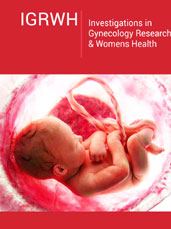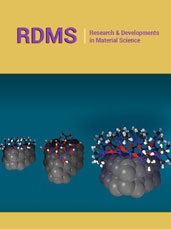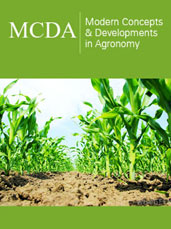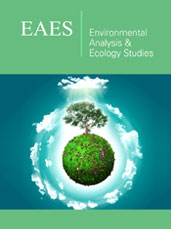- Submissions

Full Text
Investigations in Gynecology Research & Womens Health
Pregnancy Outcomes after Antepartum Diagnosis of Oligohydramnios at or Beyond 34 Weeks
Inshal Jawed1*, Fasiha Bakhtawar Fatima1, Mohammad Omer Alam2, Hina Khan3, Basma wahab Memon4, Komal Devi5, Rahul Rai6, Muhammad Umair7, Farah Alam8, Shaheer Afsah Jawed8 and Sumbul Mukhtar9
1Department of Internal Medicine, Dow University of Health Sciences, Pakistan
2Department Internal Medicine, Jinnah Sindh Medical University, Pakistan
3Department of general surgery, Jinnah postgraduate medical centre, Pakistan
4People’s University of Medical Science and Health Nawabshah, Pakistan
5United Medical and Dental College, Pakistan
6Liaquat University of Medical and Health Sciences, Pakistan
7Dow University of Health Sciences, Pakistan
8Baqai Medical University, Pakistan
9Oral Biology Department, Bahria University of Health Sciences (BUHSC), Pakistan
*Corresponding author:Inshal Jawed, Department of Internal Medicine, Dow University of Health Sciences, Pakistan
Submission:January 23, 2025;Published: February 10, 2025

ISSN: 2577-2015 Volume5 Issue3
Abstract
Background: Amniotic fluid serves as a vital component in supporting fetal development during pregnancy. Oligohydramnios, a condition characterized by low amniotic fluid levels, presents concerns for obstetric care due to its potential implications on maternal and fetal health.
Methods: A retrospective cross-sectional study was conducted at Tertiary Care Hospital, analyzing the records of 50 pregnant women diagnosed with oligohydramnios at or after 34 weeks of gestation. Various demographic characteristics, maternal risk factors, mode of delivery, and neonatal outcomes were assessed.
Result: The analysis revealed several significant associations between oligohydramnios and adverse pregnancy outcomes. Women diagnosed with oligohydramnios exhibited higher gravidity and parity, along with increased risks of preterm birth, low birth weight in infants, and neonatal complications. The mode of delivery was significantly correlated with gestational age at delivery, impacting the incidence of emergency cesarean sections.
Conclusion: This study sheds light on the associations between oligohydramnios and adverse pregnancy outcomes, urging clinicians to consider close monitoring and tailored management strategies for pregnancies diagnosed with this condition.
Keywords:Oligohydramnios; New born complications; Maternal outcomes; Fetal death; Amniotic fluid
Introduction
The presence of amniotic fluid is one of the initial indicators of pregnancy [1,2]. Because it provides physical support and aids the growing lungs of the unborn child, it is essential for a healthy pregnancy. Although it fluctuates with gestational age, the typical volume of amniotic fluid at term is approximately 400mL [3,4]. Finding out how much amniotic fluid is present is a crucial aspect of obstetric care. Intrusive dye dilution is the gold standard for accurately measuring amniotic fluid levels [5]. It has been demonstrated that three non-invasive methods the two-diameter pocket, the four-quadrant amniotic fluid index, and the single deepest pocket are accurate [6,7]. Oligohydramnios is present when any of the following may be observed: a maximum deepest pocket measurement below 2 cm, an amniotic fluid index measurement below 5 cm, or an amniotic fluid volume below 5% for the gestational age. The most reliable method for identifying oligohydramnios is SDP [8]. On the other hand, most studies that look at negative impacts use AFI. The presence of oligohydramnios is deemed abnormal regardless of the method employed. It is uncommon for oligohydramnios to be present in otherwise healthy pregnancies; nonetheless, it is more commonly associated with pregnancies that are difficult, such as those with hypertensive problems or limited fetal movement. The research shows that oligohydramnios raises the likelihood of problems in complicated pregnancies. caesarean section, low birth weight compared to gestational age, respiratory distress syndrome, low 5-minute Apgar score, meconium-stained amniotic fluid, caesarean admission, and low birth weight relative to gestational age are all possible outcomes [9-17].
However, whether or not isolated oligohydramnios are relevant is debatable. Early detection and treatment of these diseases can improve outcomes for both mothers and their babies. When oligohydramnios is detected, it can result in the administration of amnioinfusion, the commencement of the labour process at a younger age, or possibly a caesarean section [18,19]. However, many concerns about oligohydramnios remain unresolved, including how common it is in countries with low incomes, what role underlying causes play, and whether or not oligohydramnios is associated with unfavourable pregnancy outcomes [20,21]. Oligohydramnios alters prenatal care and may indicate that the mother needs to give birth. Induction, at certain gestational ages, increases the chance of caesarean section and late preterm/ early term deliveries. So, it’s important to explain the benefits of having a baby early and the risks of oligohydramnios. Lastly, fifty patients admitted to a tertiary care hospital in Karachi, Pakistan, were the subjects of this retrospective cross-sectional study. This study delves into the intricate landscape of pregnancy outcomes following an antepartum diagnosis of oligohydramnios. We hope that by shedding light on key factors affecting maternal and fetal health, our study may help us navigate the complexities of this condition. Through informing clinical practices and prenatal care efforts, we hope to shed light on the significance of antepartum and ultimately enhance the health of women and their infants.
Method
Study design and data extraction
This was a Retrospective cross-sectional study conducted at Tertiary Care hospital. The records of pregnant women were searched from December 2022 till December 2023, they were included if they were diagnosed as Oligohydramnios patients at or after 34 weeks of gestation. The diagnosis of Oligohydramnios was established when AFI was less than 50 on Ultrasound. Ethical approval was obtained from the Tertiary Care Hospital institutional review board (IRB Approval No# SGQH/268). Following demographic Characteristics of the pregnant female were extracted: Age, Gravidity (Total number of pregnancies), Education, Parity (Number of Live births), Gestational Age at Diagnosis of Oligohydramnios (weeks), Gestational Age at delivery (weeks), hospital stay duration of the mother, Previous Pregnancy Complications, any known causes of oligohydramnios, mode of Delivery and Maternal/Delivery Complications (if any). Maternal risk factors incidence recorded were water leak during pregnancy, Obese (BMI more than 25kg/m2), Pregnancy Induced Hypertension (No proteinuria), Gestational diabetes mellitus, Premature Preterm Rupture of Membranes, Malaria in pregnancy, Anemia during Pregnancy, Preeclampsia (with proteinuria) and Multiple gestation. Birth Weight (grams), Apgar Score (immediately after birth), Hospital Stay Duration of the Baby (days), Congenital anomaly, Low birth weight, Neonatal death <28 days, Preterm Birth and Stillbirth are the outcomes obtained from the records pertaining to the neonates.
Statistical analysis
For the statistical analysis, version 20 of SPSS was utilized. Categorical variables were expressed as Frequencies and percentages and continuous variables with Mean and standard deviation. Using the results of the Shapiro-Wilk test normal distribution was evaluated, when comparing categories with continuous variables, the Mann-Whitney U or students t-test were applied accordingly. Chi-square test was used to compare the category variables, moreover, Pearson and Spearman correlation test were adopted to find an association between continuous variables. Kruskal-Wallis Test and Anova test were applied to observe any correspondence between non-dichotomous and Continuous variables. P value of <0.05 was considered statistically significant.
Result
50 pregnant women were identified as Oligohydramnios patients at or after 34 weeks. Mean age of women included were 28.28, SD=4.076 and mean GA at diagnosis of Oligohydramnios 34.97, SD=0.863. Demographic details are presented in Table 1 & Table 2, Maternal Risk factors in Table 3 and Neonatal complication in Table 4. In our analysis of checking the outcomes of pregnancy in women who had been diagnosed with oligohydramnios at or beyond 34 weeks, we found that women with oligohydramnios had decreased hospital stays when diagnosed with malaria in pregnancy (p=0.019). Infants from women diagnosed with preeclampsia (with proteinuria) had lower Apgar scores (p=0.038). Infants with low birth weight were found to have low gestational age at delivery and longer hospital stay duration (p=0.026, p=0.009, respectively). Women diagnosed with oligohydramnios were found to have higher gravidity, parity, longer hospital stay duration of the baby, and lower Apgar scores with the incidence of neonatal death <28 days (p=0.049, p=0.029, p=0.015, p=0.013, respectively. Further analysis showed a significant correlation of preterm birth occurrence with lower gestational age at delivery and higher hospital stay duration of the baby (p=0.000017, p=0.024, respectively) It was found that the mode of delivery for women with oligohydramnios was significantly associated with gestational age at the delivery (p=0.035), for the women with low gestational age at delivery they mostly if not all had to undergo Emergency C-section. We also found a significant correlation between water leak incidence and low birth weight (p=0.046).
Table 1:Demographic details.

Table 2:Demographic details.

Table 3:Maternal risk factors.

Table 4:Newborn complications.

There was a strong correlation between decreased gestational age at diagnosis with decreased hospital stay duration of the baby (p=0.035). Infants with higher gestational age at delivery were found to have higher Apgar scores (p=0.001). Similarly, women with increased age and higher gravidity, their newborns were also found to have higher Apgar scores (p=0.026). It was found that there was a notably decreased hospital stay of the baby and mother, with the infants with low birth weight (p=0.002, p=0.013, respectively). Infants with higher birth weights were found to have high Apgar scores (p=0.049). Women with pregnancy-induced hypertension (without proteinuria), had their newborns with low birthweight (p=0.041).
Discussion
One of the first and most obvious signs of pregnancy is the presence of amniotic fluid. The placenta plays an essential role in a healthy pregnancy by acting as a physical barrier that aids in the expansion and maturation of the developing embryonic lungs. Finding out how much amniotic fluid is present is a crucial aspect of obstetric care [22]. The last meta-analysis was conducted by Chauhan et al. [23]. The likelihood of three specific adverse outcomes-cesarean delivery due to fetal distress, 5-minute Apgar score below 7, and umbilical artery pH below 7.0-was determined by comparing women whose antepartum and intrapartum Amniotic Fluid Index (AFI) was 5.0cm or less to those whose AFI was greater than 5.0cm. Whether it happens before or during delivery, oligohydramnios increases the chance of a caesarean surgery due to fetal discomfort and a 5-minute Apgar score below 7. Yet, acidosis remained unaltered. We analyse oligohydramnios, which happens within a week after birth, and classify pregnancies as either low-risk or high-risk, expanding on their previous work. The Mycoplasma Aspiration Syndrome (MAS) and meconium staining in amniotic fluid are only two of the many potential side effects that we look at.
This study sheds light on two crucial aspects of oligohydramnios in relation to typical amniotic fluid in both straightforward and intricate pregnancies. Even in low-risk, simple pregnancies, solitary oligohydramnios increases the risk of complications such as Meconium Aspiration Syndrome (MAS), fetal distress requiring a caesarean section, and admission to the Newborn Intensive Care Unit (NICU). The likelihood of stillbirth or prenatal mortality is not quantifiable because it is an uncertain variable. The number of stillbirths in these trials was extremely low. For this reason, most studies did not include stillbirth as a measure, and the few that did usually only consider a tiny subset of cases. Casey and his colleagues at the office [24]. Despite the fact that it is difficult to determine whether oligohydramnios treatment reduces stillbirth rates, a correlation between the two has been demonstrated. This correlation raises the possibility that a delivery between 36 and 37+6 weeks of gestation could reduce the chance of stillbirth [25].
However, if the prenatal tests provide confidence, it might be reasonable to consider carrying the baby to 38 or 39 weeks of gestation in a normally easy pregnancy. Patients undergoing labor induction due to isolated oligohydramnios should also be considered for an entrance contraction stress test; nevertheless, this measure may not always be effective in avoiding a caesarean section. This could be helpful in determining if a planned caesarean section is preferable to an emergency one for some patients. Plus, there is a safe and well-tolerated way to treat isolated oligohydramnios: maternal hydration [26].
Premature birth weight in infants born to women with certain health conditions may indicate a more serious issue. This group of pregnant women had a variety of common medical issues, such as gestational diabetes, hypertension, fetal growth limitation, rhesus isoimmunization, and other related disorders. A higher risk of low birth weight at delivery was the sole difference in outcomes between oligohydramnios patients and the general population, despite all these obstacles. Comorbidities, most of which were associated with prenatal growth restriction, or a more severe form of the disease could account for this finding. Since oligohydramnios typically signals an underlying problem, it is advisable to concentrate on managing the pregnancy issue rather than changing the management strategy solely because of its presence.
Two of the strongest aspects of the study are the robust methodology and the comprehensive review of many publications. The primary focus at Rob was the process for choosing patients. Although all controlled studies were considered, the possibility of patient selection bias was higher in case-control designs, nonrandom patient selection, and studies that included preterm pregnancies (in the low-risk category). The high-risk group did not perceive preterm pregnancies as a greater threat because of the prevalent association of premature births with difficult pregnancies. Because our research was based on strict criteria, the other domains’ incidence rate was quite low. Because all trials employed the same method and standards to detect oligohydramnios, and because there was less than one week between diagnosis and delivery, there were no serious worries regarding the application of the findings and the likelihood of bias was minor.
The investigation’s scope is constrained since pertinent outcome data is lacking. To ensure the validity of the metaanalysis, it is imperative that all studies maintain consistency in their outcome variables. This criterion was crucial for our analysis, even though each experiment assessed multiple outcome characteristics. In our meta-analysis, we just considered the characteristics that were specific to the trials. Another limitation is that, as previously stated, it is not possible to comment on the risk of stillbirth or perinatal mortality. Research that included studies that diagnosed oligohydramnios using Amniotic Fluid Index (AFI) rather than Single Deepest Pocket (SDP) was also considered. Recent developments, such as the recently announced safety trial results, [27] The SDP (Single Deepest Pocket) method is superior for diagnosing oligohydramnios since it reduces the detection rate while maintaining the same rate of intervention (like induction of labor) and undesirable consequences. The Amniotic Fluid Index (AFI) can diagnose oligohydramnios, but there is a lot of evidence that it can have bad effects. The primary purpose of this experiment was to assess unintended outcomes, not to compare various diagnostic procedures. Another disadvantage of this and comparable studies that examines the ultrasonography assessment of amniotic fluid quantity is that it is applicable just before and during delivery. At issue here are discrepancies in results obtained from the same or various observers. [28] force applied to the transducer during the ultrasonic scan, [29] ambient temperature [30] altitude [31], maternal position [32] and biases of maternal comorbidities.
Although oligohydramnios is a known anomaly in low-risk pregnancies, there is currently insufficient data to determine the optimal delivery date to minimize problems. Additional research is needed to understand perinatal mortality, particularly in relation to oligohydramnios. Treatment choices for pregnancies that are challenging and have low amniotic fluid levels should take the underlying medical conditions into account. Due to the small sample size and cross-sectional study methodology, we are unable to draw any firm inferences regarding causation from our data.
Conclusion
The investigation of pregnancy outcomes in cases of oligohydramnios diagnosed at or beyond 34 weeks illuminates critical aspects influencing maternal and neonatal health. Our retrospective cross-sectional study involving 50 pregnant women at Tertiary Care Hospital provided valuable insights into this complex condition. From our analysis, it was evident that women diagnosed with oligohydramnios exhibited varying outcomes, including decreased hospital stays in the presence of malaria during pregnancy, lower Apgar scores in infants born to mothers with preeclampsia (with proteinuria), and prolonged hospital stays for infants with low birth weight. Notably, the incidence of neonatal death <28 days correlated with specific maternal factors and delivery characteristics.
These findings underscore the importance of timely diagnosis and vigilant management of oligohydramnios in obstetric care. The study revealed associations between oligohydramnios and adverse outcomes, highlighting the significance of addressing underlying causes and implementing appropriate interventions. Moreover, correlations between gestational age, mode of delivery, and maternal risk factors emphasize the need for tailored approaches in managing pregnancies complicated by oligohydramnios. However, the study has inherent limitations due to its small sample size and cross-sectional design, which restrict the ability to establish causation. Further research, encompassing larger cohorts and longitudinal assessments, is imperative to discern causative factors and refine clinical management strategies. Our study contributes to the expanding knowledge base surrounding oligohydramnios, urging continued research efforts to enhance prenatal care and improve maternal-infant health outcomes.
Authors Contribution
A. Dr. Inshal Jawed: Critical revision, Data acquisition, Data
interpretation, drafting
B. Dr. Omer: Critical revision, Data acquisition, Data
interpretation, drafting
C. Dr. Hina Khan: Critical revision, Data acquisition, Data
interpretation, drafting
D. Dr. Fasiha Bakhtawar: Critical revision, Data acquisition,
Data interpretation, drafting
E. Dr. Basma wahab Memon: Critical revision, Data
acquisition, Data interpretation, drafting
F. Dr. Komal Devi: Critical revision, Data acquisition, Data
interpretation, drafting
G. Dr. Rahul Rai: Critical revision, Data acquisition, Data
interpretation, drafting
H. Dr. Muhammad Umair Qadir: Critical revision, Data
acquisition, Data interpretation, drafting
I. Dr. Farah Alam: Critical revision, Data acquisition, Data
interpretation, drafting
J. Dr. Shaheer afsah Jawed: Critical revision, Data acquisition,
Data interpretation, drafting
K. Dr. Sumbul Mukhtar: Critical revision, Data acquisition,
Data interpretation, drafting
Ethics Approval
The Institutional Review Board of Tertiary Care Hospital Karachi approved the study protocol. (IRB Approval No# SGQH/268).
References
- Timor-Tritsch IE, Farine D, Rosen MG (1988) A close look at early embryonic development with the high-frequency transvaginal transducer. Am J Obstet Gynecol 159(3): 676-681.
- Crespigny LC, Cooper D, McKenna M (1988) Early detection of intrauterine pregnancy with ultrasound. J Ultrasound Med 7(1): 7-10.
- Gadd RL (1966) The volume of the liquor amnii in normal and abnormal pregnancies. J Obstet Gynaecol Br Commonw 73(1): 11-22.
- Brace RA, Wolf EJ (1989) Normal amniotic fluid volume changes throughout pregnancy. Am J Obstet Gynecol 161(2): 382-388.
- Charles D, Jacoby HE (1966) Preliminary data on the use of sodium aminohippurate to determine amniotic fluid volumes. Am J Obstet Gynecol 95(2): 266-269.
- Phelan JP, Smith CV, Broussard P, Small M (1987) Amniotic fluid volume assessment with the four-quadrant technique at 36-42 weeks' gestation. J Reprod Med 32(7): 540-542.
- Manning FA, Platt LD, Sipos L (1980) Antepartum fetal evaluation: Development of a fetal biophysical profile. Am J Obstet Gynecol 136(6): 787-795.
- Nabhan AF, Abdelmoula YA (2008) Amniotic fluid index versus single deepest vertical pocket as a screening test for preventing adverse pregnancy outcome. Cochrane Database of Systematic Reviews (3): CD006593.
- Youssef AA, Abdulla SA, Sayed EH, Salem HT, Abdelalim AM, et al. (1993) Superiority of amniotic fluid index over amniotic fluid pocket measurement for predicting bad fetal outcome. South Med J 86(4): 426-429.
- Magann EF, Kinsella MJ, Chauhan SP, McNamara MF, Gehring BW, et al. (1999) Does an amniotic fluid index of </=5cm necessitate delivery in high-risk pregnancies? A case-control study. Am J Obstet Gynecol 180(6 Pt 1): 1354-1359.
- Driggers RW, Holcroft CJ, Blakemore KJ, Graham EM (2004) An amniotic fluid index <or =5 cm within 7 days of delivery in the third trimester is not associated with decreasing umbilical arterial pH and base excess. J Perinatol 24(2): 72-76.
- Rutherford SE, Phelan JP, Smith CV, Jacobs N (1987) The four-quadrant assessment of amniotic fluid volume: An adjunct to antepartum fetal heart rate testing. Obstet Gynecol 70(3 Pt 1): 353-356.
- Magann EF, Chauhan SP, Martin JN (2003) Is amniotic fluid volume status predictive of fetal acidosis at delivery? Aust NZ J Obstet Gynaecol 43(2): 129-133.
- Casey BM, McIntire DD, Bloom SL, Lucas MJ, Santos R, et al. (2000) Pregnancy outcomes after antepartum diagnosis of oligohydramnios at or beyond 34 weeks' gestation. Am J Obstet Gynecol 182(4): 909-912.
- Alchalabi HA, Obeidat BR, Jallad MF, Khader YS (2006) Induction of labor and perinatal outcome: The impact of the amniotic fluid index. Eur J Obstet Gynecol Reprod Biol 129(2): 124-127.
- Sultana S, Akbar Khan MN, Khanum Akhtar KA, Aslam M (2008) Low amniotic fluid index in high-risk pregnancy and poor apgar score at birth. J Coll Physicians Surg Pak 18(10): 630-634.
- Venturini P, Contu G, Mazza V, Facchinetti F (2005) Induction of labor in women with oligohydramnios. J Matern Fetal Neonatal Med 17(2): 129-132.
- Butt FT, Ahmed B (2011) The role of antepartum transabdominal amnioinfusion in the management of oligohydramnios in pregnancy. J Matern Fetal Neonatal Med 24(3): 453-457.
- Turhan NÖ, Atacan N (2002) Antepartum prophylactic transabdominal amnioinfusion in preterm pregnancies complicated by oligohydramnios. International Journal of Gynecology & Obstetrics 76(1): 15-21.
- Hesson A, Langen E (2018) Outcomes in oligohydramnios: The role of etiology in predicting pulmonary morbidity/ mortality. Journal of Perinatal Medicine 46(8): 948-950.
- Melamed N, Pardo J, Milstein R, Chen R, Hod M, et al. (2011) Perinatal outcome in pregnancies complicated by isolated oligohydramnios diagnosed before 37 weeks of gestation. Am J Obstet Gynecol 205(3): 241.e1-241.e6.
- Rabie N, Magann E, Steelman S, Ounpraseuth S (2017) Oligohydramnios in complicated and uncomplicated pregnancy: A systematic review and meta-analysis. Ultrasound Obstet Gynecol 49(4): 442-449.
- Chauhan SP, Sanderson M, Hendrix NW, Magann EF, Devoe LD (1999) Perinatal outcome and amniotic fluid index in the antepartum and intrapartum periods: A meta-analysis. Am J Obstet Gynecol 181(6): 1473-1478.
- Spong CY, Mercer BM, D'Alton M, Kilpatrick S, Blackwell S, et al. (2011) Timing of indicated late-preterm and early-term birth. Obstet Gynecol 118(2 Pt 1): 323-333.
- Gizzo S, Noventa M, Vitagliano A, Dall'Asta A, D'Antona D, et al. (2015) An update on maternal hydration strategies for amniotic fluid improvement in isolated oligohydramnios and normohydramnios: Evidence from a systematic review of literature and meta-analysis. Plos One 10(12): e0144334.
- Kehl S, Schelkle A, Thomas A, Puhl A, Meqdad K, et al. (2016) Single deepest vertical pocket or amniotic fluid index as evaluation test for predicting adverse pregnancy outcome (SAFE trial): A multicenter, open-label, randomized controlled trial. Ultrasound Obstet Gynecol 47(6): 674-679.
- Sande JA, Ioannou C, Sarris I, Ohuma EO, Papageorghiou AT (2015) Reproducibility of measuring amniotic fluid index and single deepest vertical pool throughout gestation. Prenat Diagn 35(5): 434-439.
- Flack NJ, Doré C, Southwell D, Kourtis P, Sepulveda W, et al. (1994) The influence of operator transducer pressure on ultrasonographic measurements of amniotic fluid volume. Am J Obstet Gynecol 171(1): 218-222.
- Sciscione AC, Costigan KA, Johnson TR (1997) Increase in ambient temperature may explain decrease in amniotic fluid index. Am J Perinatol 14(5): 249-251.
- Yancey MK, Richards DS (1994) Effect of altitude on the amniotic fluid index. J Reprod Med 39(2): 101-104.
- Patrelli TS, Berretta R, Noventa M, Gizzo S (2014) Reply: To PMID 22298867. J Ultrasound Med 33(5): 922-923.
- Gizzo S, Patrelli TS, Rossanese M, Noventa M, Berretta R, et al. (2013) An update on diabetic women obstetrical outcomes linked to preconception and pregnancy glycemic profile: A systematic literature review. Scientific World Journal 2013: 254901.
© 2025 Inshal Jawed. This is an open access article distributed under the terms of the Creative Commons Attribution License , which permits unrestricted use, distribution, and build upon your work non-commercially.
 a Creative Commons Attribution 4.0 International License. Based on a work at www.crimsonpublishers.com.
Best viewed in
a Creative Commons Attribution 4.0 International License. Based on a work at www.crimsonpublishers.com.
Best viewed in 







.jpg)






























 Editorial Board Registrations
Editorial Board Registrations Submit your Article
Submit your Article Refer a Friend
Refer a Friend Advertise With Us
Advertise With Us
.jpg)






.jpg)














.bmp)
.jpg)
.png)
.jpg)










.jpg)






.png)

.png)



.png)






